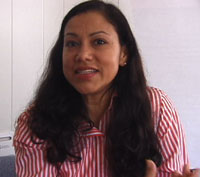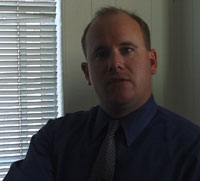From
Donation
to Transplant
OPOs
Tissue
Banks
Transplant
Recipient
Living
Donation
Organ Procurement Organizations
There are 59-federally designated organ procurement
organizations (OPO) in the United States. All of them follow regulations
and policies set by the United Network for Organ Sharing.
When patient death is imminent, hospital staff contacts the local organ procurement organization.
This initial contact starts a flurry of phone calls
between the hospital, the OPO, and possibly, a tissue bank.
 |
| Yanira Vazquez-Azpiri of CTDN works with donor families. Hear her story. |
When the OPO gets the referral, they ask the nurse
questions about the patient. Based on that information, they will dispatch
a coordinator to the hospital to start the process.
The coordinator will be dispatched if the patient
has been declared brain dead.
If a diagnosis of brain death has not been made, the OPO will simply stay
in contact.
There is no absolute age limit for organ donation
but there are some medical conditions that will rule out organ donation.
These conditions include HIV and actively spreading cancer or certain
severe infections, according to the Organ Procurement Transplant Network.
If the OPO finds the brain-dead patient suitable
for donation, they approach the family for consent, whether or not the
patient carried a donor card. If they receive
consent, and if tests determine the organs are viable for transplant,
the OPOs placement department requests a list of compatible patients from
the United Network for Organ Sharing.
While potential recipients are being located, the
brain dead donor is kept on the ventilator to preserve the body. Drugs
and medications maintain blood pressure and other body functions.
| Where organs go |
All organs are first allocated locally, and organ procurement organizations work closely with the transplant centers in their region. For example, a majority of the organs the California Transplant Donor Network recovers from the 160 hospitals it serves are offered to recipients listed with these transplant centers:
|
When the OPO placement coordinator identifies a
recipient through UNOS, the donor's medical information is transmitted
to the transplant coordinator or surgeon that is treating the patient
waiting for a transplant. They have one hour to accept or decline the
organ, based on careful consideration of the organ's suitability and the
intended recipient's current medical condition.
If the organ is not accepted for the first patient
on the waiting list, the next patient on the list is offered the organ.
This process continues until the organ is finally accepted. The same process
is followed simultaneously for all the donor's organs that are suitable
for transplant.
 |
| John Lilley of CTDN works with organ donors. Hear his story. |
Then, the focus is on organ recovery.
- A time is set for organ recovery.
- The OPO procurement coordinator maintains the donor's body until the surgeons arrive who will later perform the transplant surgery on the recipients of the organs.
- An OPO surgical coordinator and the transplant surgeons recover the organs.
- Once the organs have been recovered, the transplant surgeons return to their respective transplant centers where their patients are waiting to undergo surgery.
- OPO coordinators stay behind and follow the
deceased patient to the morgue.
©2003 Gina Comparini
